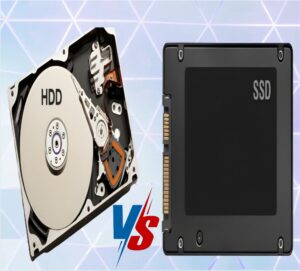Introduction
In today’s digital world, storage devices are crucial for both personal and professional computing. Whether you're a gamer, a content creator, or simply a casual user, the debate between HDD (Hard Disk Drive) and SSD (Solid State Drive) continues to be relevant. This blog will guide you through the essential differences between these two storage technologies, helping you make an informed decision.

What is an HDD (Hard disk drive)?
An HDD, or Hard Disk Drive, is the traditional storage device used in computers since the 1950s. It stores data on spinning magnetic disks, known as platters. A mechanical arm with a read/write head accesses data while the platters spin.
Key Features
- Moving mechanical parts
- Data stored magnetically
- Typically larger in size
- Common in older PCs and budget-friendly systems
What is an SSD (Solid state drive)?
An SSD, or Solid State Drive, is a newer type of storage that stores data on flash memory chips. It has no moving parts, which results in faster performance and greater durability.
Key Features
- No mechanical components
- Uses NAND flash memory
- Faster data access and boot times
- Common in modern laptops, gaming PCs, and ultrabooks
Differences Between HDD (Hard disk drive) and SSD (Solid state drive)
| Feature | HDD | SSD |
|---|---|---|
| Speed | Slower (50–120 MB/s) | Much faster (200–5500 MB/s depending on type) |
| Durability | More prone to physical damage due to moving parts | More resistant to shock and damage |
| Power Consumption | Higher | Lower |
| Noise | Produces sound due to spinning platters | Completely silent |
| Weight | Heavier | Lighter |
| Cost | Cheaper per GB | More expensive per GB |
| Lifespan | Long lifespan but can fail due to mechanical wear | Limited write cycles but improving with modern technology |
| Data Retrieval in Case of Failure | Easier and cheaper to recover | More difficult and costly to recover |
Performance Comparison
| HDD | SSD | |
|---|---|---|
| Boot Time | 30–40 seconds | 5–15 seconds |
| File Transfer Speed | ~100 MB/s | 500 MB/s to 5000 MB/s (based on SATA or NVMe) |
| Gaming and Applications | load games and apps slower | load games and apps faster |
| Suitable For | Large file storage (movies, backups), Budget-conscious users, Systems where speed is not critical |
Fast boot and application loading, Gaming and video editing, Lightweight laptops and tablets |
Conclusion
While HDDs offer higher storage at a lower cost, SSDs provide unmatched speed and performance. In many modern systems, a hybrid approach is also used — an SSD for the operating system and frequently used programs, and an HDD for mass storage.Your choice should depend on your specific needs, budget, and desired system performance. For most users, upgrading to an SSD is one of the easiest and most impactful ways to improve computer speed and responsiveness.